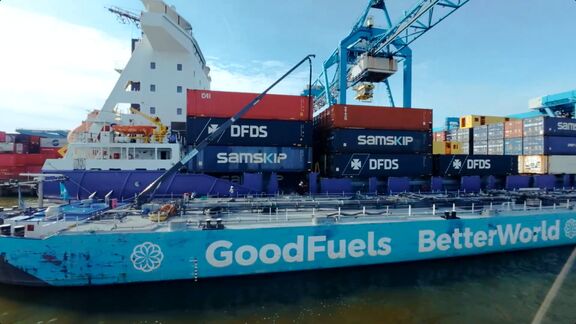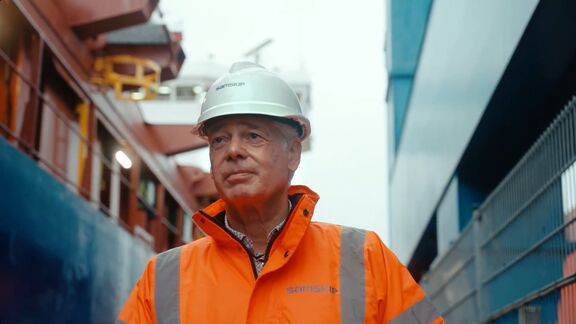Samskip aims for sustainable supply chain
Reading time: 4 minutes
“By working together, we win together”
For years Samskip has been aiming to minimize greenhouse gas emissions from transport. The multimodal logistics provider developed several initiatives, the effects of which are not only felt within its own operations. The entire supply chain benefits. And there is even more in the pipeline.
As a multimodal logistics provider, aside from providing its customers with the best most reliable service possible, Samskip has CO2 reduction highest on its agenda. For years, thousands of containers have been taken off the road and transported in cleaner ways. “But we can't sit still,” Pedro Vasconcellos, Head of Sustainability at Samskip, knows. “We continue working on pioneering, positive changes. Changes that have a lasting impact. We do that with everyone who is in line with our mission - by working together, we win together.”
Collaboration across the chain
“We are in continuous dialogue with hydrogen and fuel cell suppliers, among others,” Erik Hofmeester, Head of Vessel Management for Samskip’s ships, adds. Liquid hydrogen is the preferred choice for him: “Partly because it poses fewer risks than compressed hydrogen.”
For its green journey, Samskip collaborates with students from Erasmus University Rotterdam, Delft University of Technology and the Shipping and Transport College (STC) in Rotterdam and with European politicians - when it comes to regulations.
Hofmeester: “The current EU Emissions Trading System is not always justified as it presently exempts smaller vessels below 5000G. A level playing field is crucial. CO2 emissions should be charged across the board, including slightly smaller ships and trucks. This will encourage the multimodal shift, i.e., a shift from road transport to ships, reducing emissions and congestion.”
Substantial emissions reduction
Nevertheless, significant investments have already been made in innovative, cleaner technology. Samskip’s ambition is to be ‘net zero’ by 2040. “That is well ahead of what is actually required,” Vasconcellos knows.
Several sustainable solutions are currently being deployed. “For example, we have five ships running on biofuel, preventing 45,000 tons of CO2 emissions per year,” says Hofmeester. By 2022, the service provider’s total CO2 emissions were reduced by 10.4% compared to the 2020 base year. In 2022, Samskip also commissioned two additional chartered-in ships running on 100% biofuels. This reduced CO2 emissions per ship by 89%.

‘Stimulating cleaner future’
“By operating on biofuels, we offer our customers a more environmentally friendly product and stimulate them to make the transition to a cleaner future,” Vasconcellos states. In doing so, the service provider is looking at and evaluating alternatives for ships as well as inland barge modes and road transport. “Moreover, with Samskip Multimodal, we received the EcoVadis Gold medal, with a score that places us in the top 2% of most sustainable companies,” the Head of Sustainability continues.
Furthermore, Samskip opened two new rail lines in 2022, which further improved the multimodal network and saved thousands of truck movements in that first year alone.
“But the thing I am most proud of is the building of two Samskip Seashuttles, 3.2 MW hydrogen-powered shortsea vessels, which will sail in a green corridor from Rotterdam to Oslo in 2026,” Hofmeester adds.

Shore power and carbon capture
In 2024, Samskip hopes to launch two more biofuel-powered ships. The company is also engaged in methanol-fueled ships, and is seriously considering a battery-powered river barge, which - if all goes according to plan - should sail between Nijmegen and Hull in 2027. Furthermore, two ships are equipped with carbon capture systems and two are running on shore power.
Here too partnership is essential, says Hofmeester: “We know how to build ships, but other parties know more about what is required for shore infrastructure. It is then good if you can collaborate with proactive partners, such as Port of Rotterdam. And because we are of course looking for standardization, we also work together with Port of Oslo, for example, for the shore power and hydrogen bunkering.”
Challenges
“The greenest energy is the energy we save/don't use, but the energy we do need should be as green as possible,” Hofmeester points out. He identifies challenges for both the short term and the longer term in this regard: “One of the bigger challenges in the short term is the supply of biofuel in the port of Rotterdam at an acceptable price level. In the longer run, the supply of liquid hydrogen at an acceptable price level is the biggest challenge. It involves substantial investments and yet we have to remain competitive. Customers are willing to pay extra for cleaner transport, but only to a certain extent. Fortunately, we see a growing number of customers open to new, cleaner technologies.”